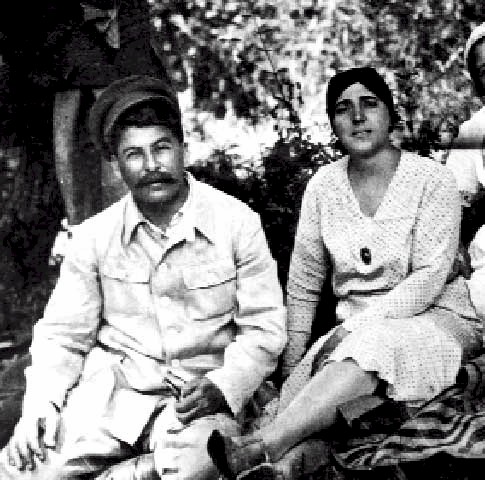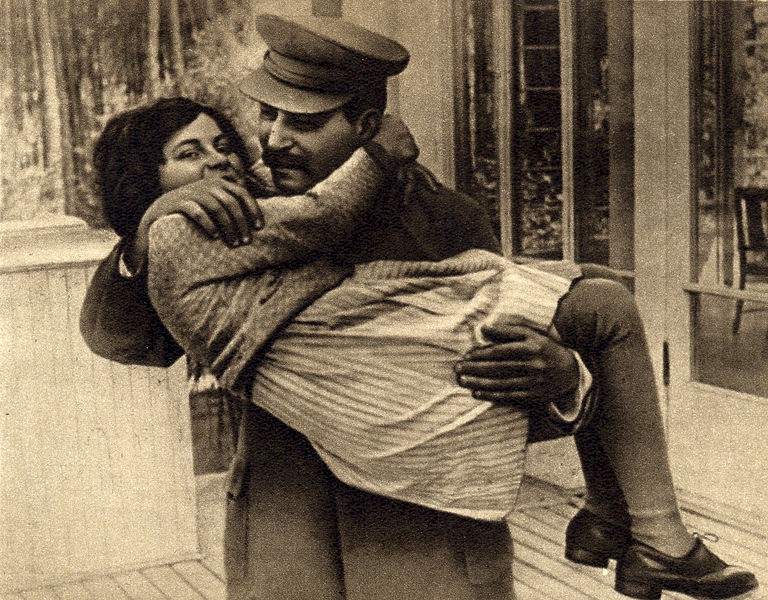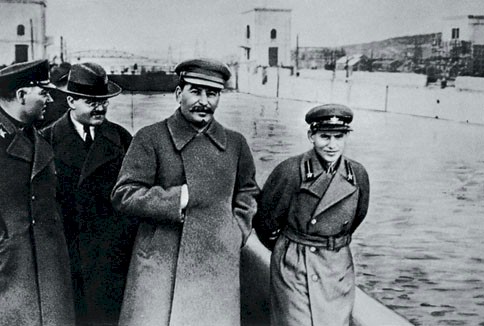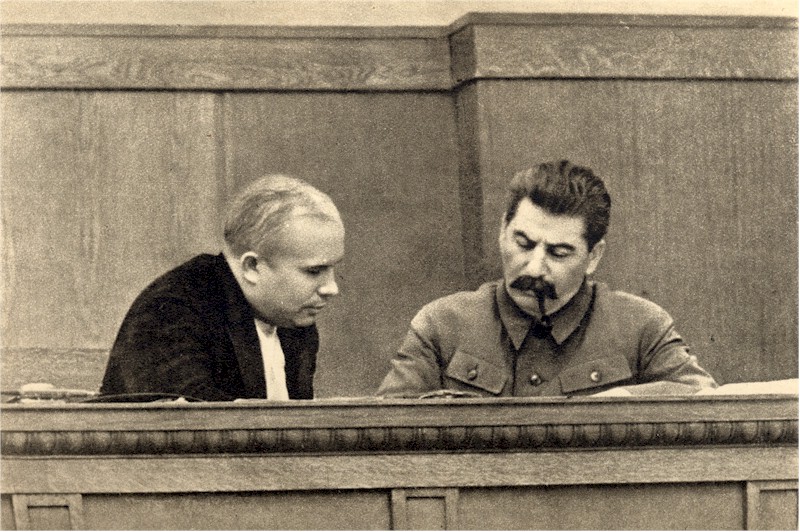Сталинская эпоха
Русский > Контекст > Политический контекст > Сталинская эпоха
1933
In January 1933, 55.000 people were already convicted following the new law, and 2.000 were shot. The extermination of the kulaks was carried on as well. The official statistics reported the deportation of another 240.000 families that year. In the winter of 1932-1933 there was famine again. Stalin's wife, Nadezhda Sergeevna Alliluyeva (1901-1932), had committed suicide. The population was starving, but they didn't dare to touch the grain of the kolkhoz farms and, despite the famine, the exportation of grain to the west didn't stop. Through fear, bloodshed and hunger, Stalin led a broken country on its way to industrialisation. On the last day of the year the first Five-Year Plan was officially declared "accomplished".
1934
The XVIIth Party Congress in January-February was called the Congress of the victors. The title of Secretary-General was changed into First Secretary. On September 18, the USSR joined the League of Nations and started promoting the idea of collective security. The country's armament was being increased. On December 1, Sergey Mironovich Kirov (1886-1934) was killed, probably with Stalin's knowledge. He was one of Stalin's friends and followers, and he had just purged the Leningrad party administration from anti-Stalin elements. But on the XVIIth Party Congress he was, against his own will, nominated as opposing candidate for Stalin by an anti-Stalin group and... he got many votes. Probably too much in Stalin's mind. The Big Terror started. Millions of people disappeared to the Gulag Archipelago
1935
In April 1935 a new law is proclaimed: children of twelve years and more will have the same punishments as adults, including death penalty. So Stalin's victims have now to seriously take into account the situation of their descendants. The Moscow metro is opened; another sign of the great future for the people. The marvelous underground palaces are meant to show the laborers in what kind of houses their children will live under communist rule.
1936
In the summer of 1936, the Great Purge was started. In December, Stalin proclaimed a new constitution by which were created, next to each other, the Supreme Soviet and the Soviet of Nationalities. The Communist Party became more powerful than ever before.
The Great Purge was typified by the infamous Moscow Show Trials, which were staged from 1936 to 1938, and during which numerous former allies of Stalin were eliminated one after another.
Click here to read more on the Show Trials
Stalin started a sudden attack on culture. A "restructuring of the cultural front" was announced. It meant that art had to be comprehensive for the hard working mass. The remainings of the avant-garde art were destroyed
1937
In 1937, when he was preparing himself to the deathblow to the old leninist guard, Stalin transformed the secret service NKVD into an enormous army, organised in divisions and with hundreds of thousands of officers and agents. A gigantic network of informants covered the entire country. At first sight they worked voluntarily, but they received regular rewards, like gradual promotions in their jobs. In 1937 Stalin stopped the ideological terror. The party officials in charge of the supervision of arts had done their work. The artistic intelligentsia was scared off and in 1937-1938 all the lives of all former leaders of the RAPP ended prematurely and almost simultaniously. Mikhail Bulgakov was left in peace though, and so were the novelist Mikhail Aleksandrovich Sholokhov (1905-1984) and composer Dmitri Dmtriyevich Shostakovich (1906-1975). Stalin also arranged that Boris Leonidovich Pasternak could not be arrested. Pasternak was the only one who dared to refuse to sign a petition for the execution of "the vermin, the saboteurs and the spies".
The functionaries responsible for the various economic sectors reported their successes, not in terms of financial figures, but in terms of the number of liquidated enemies. Besides the Party, the army was Stalin's most important concern and his main aim. While he had replaced Trotsky by Kliment Yefremovich Voroshilov (1881-1969) he had also fired all former commanders. He had continued the developments of the early thirties, and dismissed 37.000 men. But some commanding officers were untouchable. August Kork (1887-1937), the chief of the Military Academy, was the first to be arrested in May 1937. Marshal Mikhail Nikolayevich Tukhachevsky (1893-1937), a typical czarist officer, was arrested on May 27. On May 29, general Yeronim Petrovich Uborevich (1896-1937) was arrested in a railway station. Marshal Yona Emmanuilovich Yakir (1896-1937) was next. The Military Council had its meeting from June 1 to 4 at the People's Commissariat of War. More than 100 military commanders were called from the provinces because the forces were depleted by the large number of arrests: a quarter of the members was in jail. On June 11, an accelerated trial was organised with - obviously - death penalty as a result. The extermination of the old supreme command was continued in 1937 and 1938 and the army was weakened. But Stalin knew that the army would eventually come out of it stronger. The mass murder of the former officers meant that the command on the eve of the war could be handed over to younger, better trained commanders, to men for whom the civil war was nothing but a heroic myth.
As a real Caesar Stalin ensured distraction for his "happy" citizens. Above the Kremlin, for instance, were installed ruby stars and people went massively to the Red Square to watch how those stars were illuminated at night. The daily life was accompanied by thundering marching music, because this was the country of the victors. Monarchists, mensheviks, socialist-revolutionaries, the White Army… they were all defeated in the civil war and now the people could celebrate its victories in times of peace.
The Newspeak, like it was so well typified by George Orwell in his novel 1948, came to a head. In a time span of two or three Five-Year Plans the Soviets had "caught up" with the rest of the world and soon they would leave them behind. from the Holy Russia, only the beheaded churches were left. Stalin had created a country of collectiveness. People worked collectively, lived collectively in communal apartments and the free time was spent collectively. Each profession had its own feast-day. Stalin made arise Parks of Culture and Rest in the whole country. In those parks, people could have fun under the guidance of trained recreation experts, collectively, of course. Individual responsibility was out of the question, only collective responsibility existed. The collective conscience allowed the people in 1938 to live "carefree"… while the Great Terror started its most cruel episode.
1938
It was time to create the image of the "nice Stalin". It started with the rehabilitation of innocently convicted people. He set 327.000 people free, among which many militaries. The airplane designers Andrei Nikolayevich Tupolev (1888-1972) and Nikolay Nikolayevich Polikarpov (1892-1944) and other prominent engineers and scientists were set free too. The terror, which originally focused on the Party changed its course. All of the sudden it was aimed against the masses. People were arrested for incautious judgments or for a misprint in the newspaper. The army made sure that that thousands of healthy, strong people were put in labour camps. Each arrest of an "enemy of the people" was followed by the arrests of his family members, friends and acquaintances. On August 25, 1938, when the Great Terror diminished, the Presidium of the Supreme Soviet discussed the possibility to prematurely set free the prisoners who had worked hard. But in 1939 Stalin made the Presidium sign a decree which stipulated that a convicted should stay in prison until the end of his entire punishment. On November 12, 1938, Stalin received a list of people who were arrested because of serious crimes. All 3167 people had to be shot, on the orders of Stalin and Molotov.
Every once and a while Stalin crossed out a name on these horrible lists, like Boris Pasternak and Mikhail Sholokhov. They could be useful for the Party later. His signature is on 44 of such lists, meaning the execution of 44.000 people.
1939
The new Party that Stalin had created was officially presented. Half a million of new nominations had been made in the state and in the Party. At the higher levels, 293 out of 333 regional party leaders had been replaced. Ninety percent of the executive staff was less than 40 years old. Two important men had been promoted: the 43-years old Andrei Alexandrovich Zhdanov (1896-1948), son of a czarist school inspector and Kirov's successor in Leningrad, and the 45-years old Nikita Sergeevich Khrushchev (1894-1971), who had replaced Pavel Petrovich Postishev (1887-1939) in Ukraine. But the reliable Molotov remained the most important adjutant of Stalin.
Stalin openly started introducing more external characteristics of the former czar regime. The guests of a big party at the Bolshoi Theatre could see to their astonishment a group of cossack officers in the box. The amazement arose from the fact that they were wearing czarist uniforms, including gold and silver shoulder-knots. The year 1939 came to an end and Stalin's 60th birthday was nearing. It was common practice that he had planned a new theatre play at the Moscow Art Theatre in honour of his own birthday. Mikhail Bulgakov, the bard of the White officers, had been asked to write the play. But alas, Bulgakov broke a taboo: he had asked to consult documents on the life of Koba (Stalin's pet name). the play was cancelled and this was more than Bulgakov could bear. Shortly after this he died.
Поместить эту страницу |
Политический контекст
Иллюстрации
Сталин и Надежда
ССталин и его дочь Светлана
Ворошилов, Молотов, Сталин и Ежов...
... кто был застрелен в 1940
Иосиф Сталин и Никита Хрущёв




